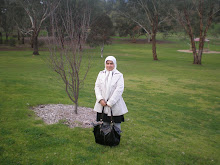A comment on my thesis topic
A librarian from the Middle-East Librarians Association (MELA), has given me a comment on my thesis topic. Following is what she/he has written:
"I've been a librarian for over 30 years and I've got an M.B.A. Business models are designed as methods to help organizations achieve the best bottom line. In other words, they are model that support competition and beating rival businesses. As we're seeing in the global economy, competition tends to end up with a few very large businesses eliminating the competition. Libraries work on a the basis of cooperation. No single library can own or provide everything, especially when services need to be delivered locally. It is essential for libraries to cooperate among themselves. The sustainable farming models would be a more suitable model for libraries, which need to adapt themselves to local conditions. Maybe you would be able to redefine a variant of those as a knowledge management system. Although, since you probably have to finish your dissertation along the lines you've started, that might be something you do later."
I think this is misunderestanding of knowledge management.
As far as I know, the KM purpose is acheiving the organization's goals. In business the goal is making more mony and competition. Non-profit organizations like libraries and governments have different goals and KM helps these kinds of organizations to reach their own aims.
As Dorabjee (2004) states: " These opportunities include saving resources and costs, working more efficiently, ensuring information expertise is deployed appropriately, turining competitors (both internal competitors: those in KM, IT, training and records management and external: publishers, deliverers of desktop e-content and other external information or service providers) into collaborators, and ultimately the opportunity to survive and thrive.
Source:
Dorabjee, S 2004, 'The business of information: are information professionals risk-averse?' Business Information Review, vol. 21, no. 3, pp. 148-56.
"I've been a librarian for over 30 years and I've got an M.B.A. Business models are designed as methods to help organizations achieve the best bottom line. In other words, they are model that support competition and beating rival businesses. As we're seeing in the global economy, competition tends to end up with a few very large businesses eliminating the competition. Libraries work on a the basis of cooperation. No single library can own or provide everything, especially when services need to be delivered locally. It is essential for libraries to cooperate among themselves. The sustainable farming models would be a more suitable model for libraries, which need to adapt themselves to local conditions. Maybe you would be able to redefine a variant of those as a knowledge management system. Although, since you probably have to finish your dissertation along the lines you've started, that might be something you do later."
I think this is misunderestanding of knowledge management.
As far as I know, the KM purpose is acheiving the organization's goals. In business the goal is making more mony and competition. Non-profit organizations like libraries and governments have different goals and KM helps these kinds of organizations to reach their own aims.
As Dorabjee (2004) states: " These opportunities include saving resources and costs, working more efficiently, ensuring information expertise is deployed appropriately, turining competitors (both internal competitors: those in KM, IT, training and records management and external: publishers, deliverers of desktop e-content and other external information or service providers) into collaborators, and ultimately the opportunity to survive and thrive.
Source:
Dorabjee, S 2004, 'The business of information: are information professionals risk-averse?' Business Information Review, vol. 21, no. 3, pp. 148-56.


0 Comments:
Post a Comment
<< Home